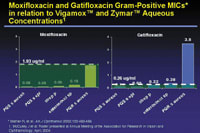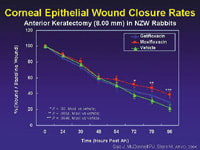research digest
Study Mimics Postoperative Antimicrobial Penetration
Ocular antibiotics, including the fourth-generation fluoroquinolones, are effective only if they can reach their target organisms. To test the penetration of moxifloxacin 0.5% (Vigamox) and gatifloxacin 0.3% (Zymar), James P. McCulley, M.D., Gordon Surratt, B.S., and Ward Shine, Ph.D., measured the concentration of these agents the aqueous humor (AH) of cataract patients in a double-masked trial. They presented preliminary results from this ongoing study at the annual meeting of the Association for Research in Vision and Ophthalmology.

Dr. McCulley and his colleagues found that patients treated with moxifloxacin had AH concentrations of 1.93 ± 0.87 µg/mL and those treated with gatifloxacin had AH concentrations of 0.26 ± 0.09 µg/mL.
The investigators attribute the higher AH concentration of moxifloxacin to a greater concentration of the active drug in the commercial formulation and better solubility at neutral pH.
"Aqueous humor fluoroquinolone concentration is important for preventing infection after cataract surgery," says Dr. McCulley. "The more antimicrobial that reaches the AH, the less likely patients are to develop endophthalmitis. Our study suggests that moxifloxacin may have an advantage over gatifloxacin in terms of AH concentration."
Because most refractive surgery involves only the cornea, endophthalmitis isn't a risk factor for these patients. But this may change as phakic IOLs become more common. "Although we've studied only cataract patients, AH penetration is definitely a concern for preventing endophthalmitis in phakic IOL patients," says Dr. McCulley.
Fluoroquinolones' Effect on Wound-Healing Examined in Rabbits
Administering prophylactic antibiotics for corneal trauma or after refractive surgery can prevent infection, but also may affect visual acuity if the agents delay corneal healing. In a recent study, Peter J. McDonnell, M.D., and colleagues monitored the effect of fourth-generation fluoroquinolones on corneal healing in a rabbit model of anterior keratectomy (AK).

Dr. McDonnell and colleagues evaluated corneal healing among the three groups according to two criteria. Using data collected with a digital slit lamp microscope and imaging software, they compared the corneal re-epithelialization rate at 72, 78 and 96 post-AK hours. Researchers also compared the distribution and quantity of type IV collagen in corneas collected from half the rabbits after 48 hours and corneas collected from the remainder after 5 days.
Results showed that compared with rabbits treated with the vehicle, rabbits treated with topical gatifloxacin showed no significant positive or negative changes in epithelial healing at all three time points. The group treated with moxifloxacin demonstrated healing delays of 13.25%, 15.76% and 16.49% at 72, 78 and 96 hours, respectively. Moxifloxacin also interrupted collagen IV production, causing a 30% decrease in novel corneal epithelial cell migration compared with gatifloxacin.
Gatifloxacin, Moxifloxacin Compared in Refractive Surgery Patients
At this year's meeting of the American Society of Cataract and Refractive Surgery, Daniel S. Durrie, M.D., presented the results of a study investigating the safety of fourth-generation fluoroquinolones in LASIK patients. In the prospective, randomized, double-masked, single-center trial, Dr. Durrie and his colleagues instilled the commercial formulations of moxifloxacin 0.5% (Vigamox) in one eye and gatifloxacin 0.3% (Zymar) in the other eye of 30 LASIK patients. "Each patient received one drop of moxifloxacin or gatifloxacin before surgery and then continued to self-administer four drops a day for 1 week," says Dr. Durrie. "We examined patients for signs of infection and used subjective patient assessments to rate comfort-related criteria such as visual acuity, redness, overall irritation, overall comfort and itching." Dr. Durrie found no significant differences between eyes treated with moxifloxacin and gatifloxacin. "We concluded that the fourth-generation fluoroquinolones appear to be safe and effective for preventing postsurgical infection in LASIK patients," says Dr. Durrie.
Gatifloxacin in the Treatment of Mycobacterial Keratitis
Surgeons are becoming increasingly aware of the role Mycobacterium chelonae infection plays in post-LASIK mycobacterial keratitis. The traditional treatment for this rare infection is a combination of topical amikacin and ciprofloxacin (Ciloxan) or amikacin and clarithromycin. In a recent study led by Joon-Young Hyon, M.D., originally published in the August issue of Archives of Ophthalmology, a team of researchers compared the efficacy of these antimicrobials with that of gatifloxacin (Zymar) for treating mycobacterial keratitis in an animal model.
After administering intrastromal injections of M. chelonae to the right eyes of 35 rabbits, the researchers observed the animals for 5 days before initiating treatment. The rabbits were randomly divided into five groups (n=7) and each group was treated with one of the following topical solutions: commercial gatifloxacin 0.3% (Zymar); commercial ciprofloxacin 0.3%; combined fortified amikacin (50 mg/mL) and clarithromyin (10 mg/mL); combined gatifloxacin 0.3%, amikacin and clarithromyin; or a control of balanced salt solution (BSS) 0.9%. The rabbits were treated hourly for 12 hours and then euthanized.
When researchers compared the bacterial load in corneal plugs harvested from the different groups, they found that rabbits treated with the triple antibiotic combination had the lowest bacterial load (1.11), compared with rabbits treated with other agents or combinations. The next best results were achieved with gatifloxacin alone (3.89). Finally, rabbits treated with the ciprofloxacin (1156.44), BSS (5383) and the amikacin/clarithromycin combination (1505.45) showed no significant differences in bacterial load.
Although they caution that surgeons may still need to use multiple-agent therapy and perform surgical debridement to completely eradicate infection, the authors conclude that "gatifloxacin can be a valuable new initial therapeutic agent in the treatment of M. chelonae keratitis."
|
Quantitative Mycobacterial Culture Results* |
||
| Treatment group (n=7) | Bacterial Load, CFUs X 10-3 | P Values |
| Amikacin, clarithromycin, gatifloxacin (Zymar) | 1.11 (1.10) | <0.001 |
| Gatifloxacin | 3.89 (9.65) | <0.001 |
| Ciprofloxacin (Ciloxan) | 1156.44 (926.95) | 0.21 |
| Amikacin and clarithromycin | 1505.45 (1413.02) | 0.51 |
| Balanced salt solution | 5383 (4263) | NA |
|
NA--not applicable *Data are given as mean (SD) Adapted from: Hyon JY, Joo MJ, Hose S, et al. Arch Ophthalmol. 2004;122:1166-1169. |
||








